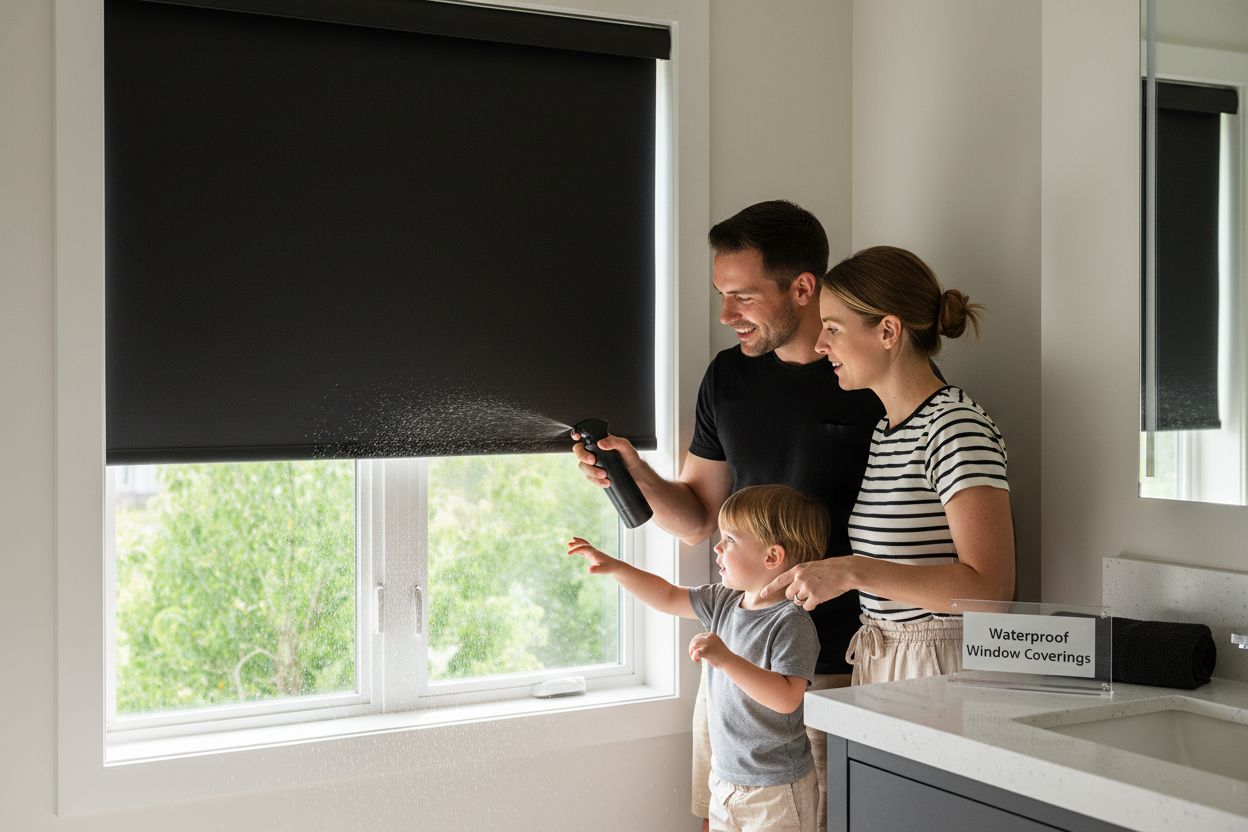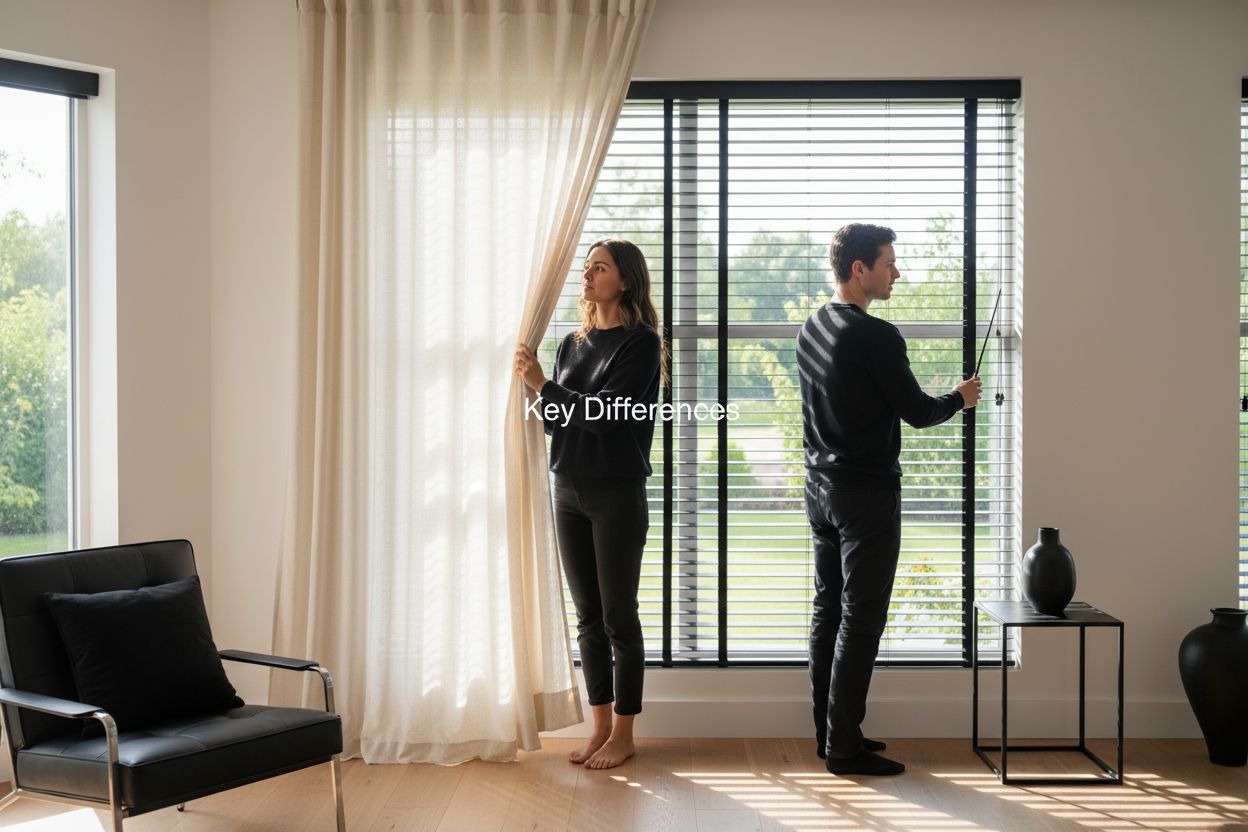
Understanding Curtains vs Blinds: Key Differences Explained
Curtains and blinds are more than just window dressing. Did you know that sheer curtains can softly filter light while blackout curtains can completely block it out, offering a perfect sleep environment any time of day? Most people assume all window coverings work the same, but curtains and blinds each offer distinct features that could transform the feel and function of your room.
Table of Contents
- What Are Curtains And Blinds?
- Why Choose Curtains Or Blinds For Your Space?
- How Curtains And Blinds Affect Light And Privacy
- Key Materials And Styles Of Curtains And Blinds
- Practical Considerations For Curtains Vs Blinds
Quick Summary
| Takeaway | Explanation |
|---|---|
| Curtains provide warmth and texture | Use curtains to add softness and acoustic control, enhancing a cozy atmosphere in living spaces. |
| Blinds allow precise light control | Adjustable slats on blinds enable tailored light levels, ideal for spaces needing exact illumination like offices and bedrooms. |
| Material selection affects aesthetics and maintenance | Choose between fabric for curtains or hard materials for blinds based on design needs and cleaning ease. |
| Cost varies by type and customization | Blinds are generally more economical, while curtains can require a higher budget for quality fabrics and custom designs. |
| Consider privacy needs when choosing | Blinds offer granular privacy control, while curtains provide full coverage, allowing for flexibility based on room function. |
What Are Curtains and Blinds?
Curtains and blinds represent two fundamental window treatment solutions designed to control light, provide privacy, and enhance interior aesthetics. While often used interchangeably, these window coverings possess distinct characteristics that make them unique in function and design.
Understanding Window Coverings
Window treatments serve multiple purposes beyond mere decoration. Curtains are fabric panels typically hung from rods or tracks, providing soft, flowing coverage for windows. They come in various lengths, materials, and styles ranging from sheer lightweight designs to heavy, insulating options. Learn more about window treatment styles can help homeowners understand their comprehensive design options.
Blinds, by contrast, are hard window coverings constructed from materials like wood, aluminum, vinyl, or composite. They feature horizontal or vertical slats that can be adjusted to control light and visibility. Blinds offer precise light management through tilting mechanisms, allowing users to create graduated levels of illumination and privacy.
Key Functional Differences
The primary distinctions between curtains and blinds emerge in their operational mechanics and aesthetic impacts. Curtains typically move vertically along a rod, offering a sweeping, dramatic effect that can dramatically transform a room’s visual landscape. They absorb sound, provide thermal insulation, and create soft textural elements.
Blind systems operate through different mechanisms like cord pulls, wand controls, or motorized options, enabling more precise light and privacy control. Their structured design allows for more granular adjustments compared to curtains’ more fluid movement.
Both window treatments offer unique advantages. Curtains introduce warmth, texture, and acoustic dampening, while blinds provide clean lines, durability, and exact light management. The choice between them depends on individual aesthetic preferences, functional requirements, and specific room characteristics.
Below is a comparison table summarizing the main differences between curtains and blinds, helping you quickly assess which option best suits your needs.
| Feature | Curtains | Blinds |
|---|---|---|
| Primary Material | Soft fabrics (cotton, linen, polyester) | Hard materials (wood, aluminum, vinyl) |
| Light Control | Filter light or block completely | Precise adjustment via slats |
| Installation | Hung from rods or tracks | Mounted inside or outside window frame |
| Maintenance | May require washing or dry cleaning | Easy surface cleaning, less frequent |
| Aesthetic Impact | Adds texture and softness | Provides clean, structured lines |
| Privacy Control | Full coverage or layered for flexibility | Granular control with adjustable slats |
| Cost Range | Wider range (depends on fabric and style) | Generally more economical |
Why Choose Curtains or Blinds for Your Space?
Selecting the right window treatment involves carefully considering multiple factors that impact both functionality and aesthetic appeal. Homeowners must evaluate specific room requirements, personal style preferences, and practical considerations when deciding between curtains and blinds.
Functional Performance Considerations
Window treatments are not merely decorative elements but critical components of interior design that influence comfort, energy efficiency, and overall living experience. Privacy control stands as a primary motivation for choosing window coverings. Learn more about selecting the best window treatments to understand nuanced selection strategies.
Blinds excel in precise light management through adjustable slats, enabling users to create graduated privacy levels. They work exceptionally well in spaces requiring exact illumination control such as home offices, bedrooms, and media rooms. Conversely, curtains provide comprehensive coverage with softer light filtering capabilities, making them ideal for living areas and spaces seeking a more relaxed aesthetic.
Design and Aesthetic Implications
The visual impact of window treatments cannot be understated. Each option communicates a distinct design language. Blinds offer clean, structured lines that complement modern and minimalist interiors, providing a sleek and organized appearance. Their materials like wood, aluminum, or composite can match various architectural styles.
Curtains introduce texture, depth, and movement into interior spaces. Their flowing fabric creates visual interest and can dramatically transform a room’s ambiance. Heavier fabrics contribute thermal insulation, while sheer materials allow soft light diffusion, making them versatile design elements.
Ultimately, the choice between curtains and blinds depends on balancing practical needs with aesthetic preferences. Factors such as room function, existing decor, natural light exposure, and personal style play crucial roles in making an informed decision.
How Curtains and Blinds Affect Light and Privacy
Understanding how window treatments interact with natural light and personal privacy reveals the sophisticated engineering behind curtains and blinds. These solutions go far beyond simple aesthetic choices, representing complex systems for environmental control within living spaces.
Light Filtering Mechanisms
Light management represents a critical function of window treatments, with each option offering unique capabilities. Blinds provide exceptional precision through adjustable horizontal or vertical slats that can be tilted to create graduated light levels. Explore advanced privacy solutions to understand the nuanced control mechanisms available.
Curtain fabrics operate differently, offering a spectrum of light transmission based on material thickness and weave density. Sheer curtains allow soft, diffused illumination, while blackout curtains can completely eliminate external light sources. This makes curtains particularly versatile for spaces like bedrooms, home theaters, and shift workers’ sleeping areas.
Privacy Control Strategies
Privacy represents another crucial consideration in window treatment selection. Blinds excel in providing granular privacy control through their precise slat adjustments. Users can position slats to block direct views while still allowing ambient light penetration. Wooden and aluminum blinds offer superior opacity compared to more translucent fabric alternatives.
Curtains create privacy through complete coverage, offering a soft, enveloping barrier between interior spaces and external environments. Layered curtain designs combining sheer and opaque fabrics enable dynamic privacy management, allowing residents to adjust protection levels throughout the day.
Both curtains and blinds contribute to creating comfortable, secure living environments by intelligently managing light and visibility.
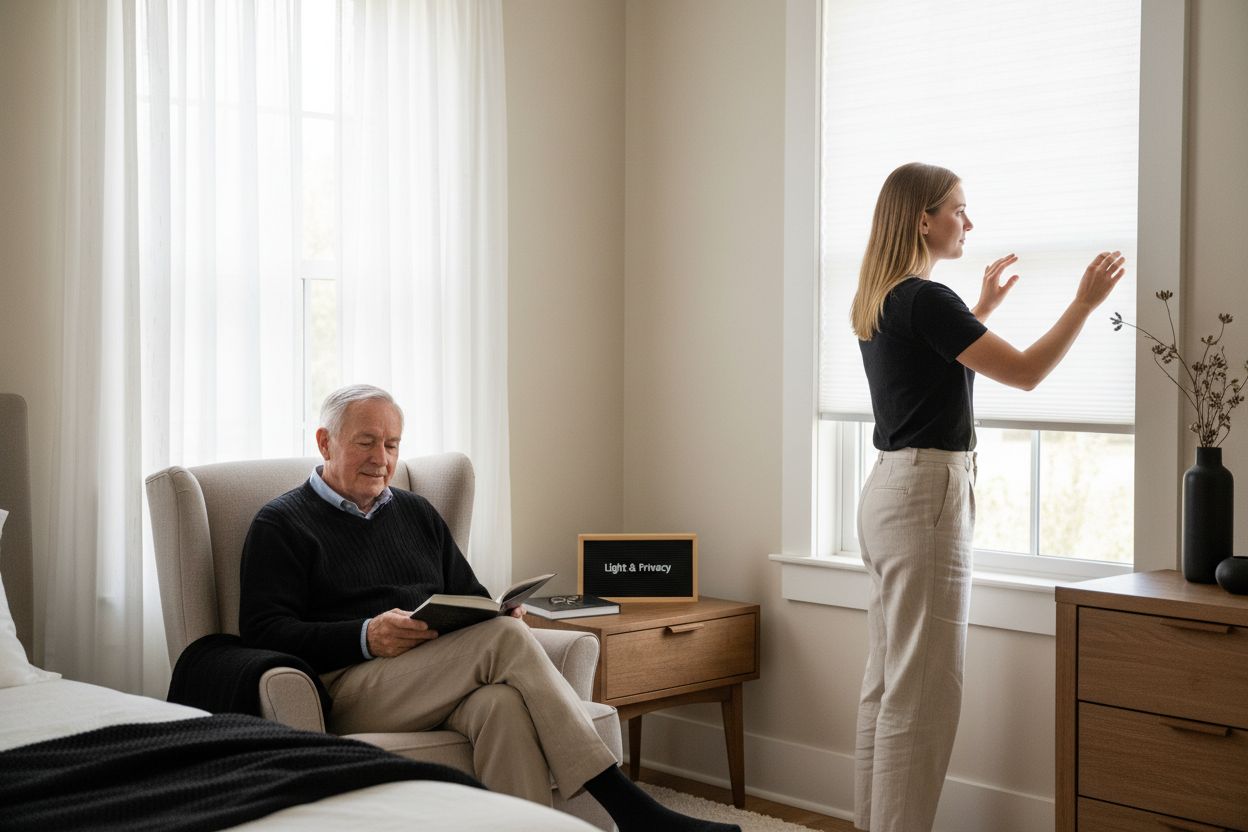 The optimal choice depends on specific room requirements, architectural characteristics, and individual lifestyle needs.
The optimal choice depends on specific room requirements, architectural characteristics, and individual lifestyle needs.
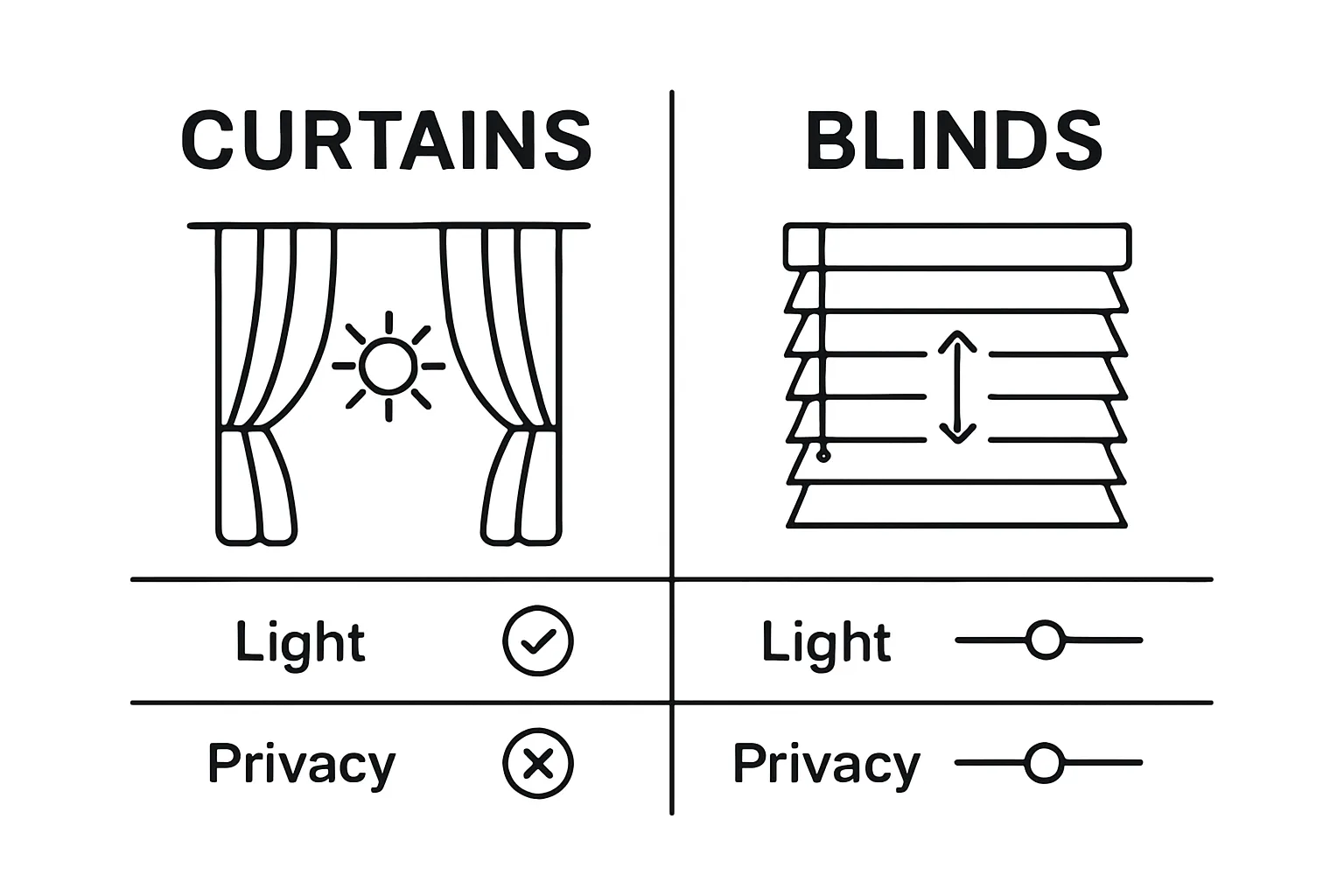
Key Materials and Styles of Curtains and Blinds
The selection of materials and styles for window treatments represents a sophisticated interplay between functional requirements, aesthetic preferences, and architectural design considerations. Understanding the nuanced characteristics of different materials can help homeowners make informed decisions about their interior spaces.
Curtain Material Diversity
Curtain fabrics range from delicate sheers to heavyweight textiles, each offering unique visual and functional properties. Natural fibers like cotton, linen, and silk provide breathable, organic textures, while synthetic materials such as polyester and microfiber offer durability and easy maintenance. Explore modern window dressing ideas to understand the expansive design possibilities.
Popular curtain styles include:
- Rod pocket curtains with gathered fabric at the top
- Grommet curtains featuring metal rings for smooth sliding
- Tab top curtains with fabric loops for a more casual aesthetic
- Pinch pleat curtains offering structured, elegant folds
Blind Material and Construction
Blind materials showcase remarkable engineering and design versatility. Wooden blinds bring warmth and natural elegance, complementing traditional and rustic interiors. Aluminum blinds provide sleek, modern aesthetics with exceptional durability and lightweight construction. Composite materials offer a cost-effective alternative that mimics more expensive options while providing excellent performance.
Blinds come in multiple distinctive styles:
- Venetian blinds with horizontal slats
- Vertical blinds ideal for large windows and sliding doors
- Roller blinds offering clean, minimalist design
- Roman blinds combining fabric softness with structured functionality
The selection of window treatments extends beyond mere decoration, representing a critical design decision that impacts room ambiance, light management, and overall interior experience. Homeowners should consider factors like room function, existing decor, maintenance requirements, and personal style when choosing between curtains and blinds.
The following table outlines major curtain and blind materials along with key characteristics, making it easier to compare their distinct properties.
| Material/Type | Curtains Key Features | Blinds Key Features |
|---|---|---|
| Cotton / Linen / Silk | Natural look, breathability, texture | N/A |
| Polyester / Microfiber | Durable, easy maintenance | Vinyl/Composite: Affordable, easy care |
| Heavyweight Fabrics | Thermal insulation, sound dampening | N/A |
| Sheer / Lightweight Fabric | Soft light diffusion, airy appearance | N/A |
| Wood | N/A | Warmth, elegance, matches traditional |
| Aluminum | N/A | Sleek, modern, lightweight |
| Composite | N/A | Resembles wood, cost-effective, durable |
Practical Considerations for Curtains vs Blinds
Choosing between curtains and blinds involves a comprehensive evaluation of multiple functional aspects that extend beyond aesthetic preferences. Homeowners must carefully assess performance characteristics, maintenance requirements, and long-term value to make informed window treatment decisions.
Maintenance and Durability
Cleaning and upkeep represent significant factors in window treatment selection. Blinds typically require less intensive maintenance, with materials like aluminum and synthetic composites offering easy surface cleaning using microfiber cloths or specialized dusting tools. Explore detailed window treatment comparison strategies to understand nuanced maintenance considerations.
Curtains demand more comprehensive care, often requiring periodic washing, professional cleaning, or specialized fabric treatments. The maintenance complexity varies significantly based on material composition:
- Synthetic fabrics tolerate machine washing
- Natural fibers like silk require professional dry cleaning
- Heavy drapes might need specialized cleaning services
- Delicate materials require gentle hand washing
Cost and Installation Considerations
Budget implications play a crucial role in window treatment selection. Blinds generally present a more economical initial investment, with materials like vinyl and composite offering cost-effective solutions. Aluminum and wooden blinds represent mid-range options, providing durability and aesthetic appeal at moderate price points.
Curtain expenses fluctuate widely depending on fabric quality, customization, and design complexity. Custom-designed curtains with premium fabrics can represent significant financial investments. Installation costs also vary:
- Blinds often feature straightforward mounting processes
- Curtain installation might require professional assistance
- Custom hardware and intricate hanging systems increase overall expenses
- Motorized options add additional cost for both curtains and blinds
The ultimate selection balances practical requirements with personal aesthetic preferences, recognizing that window treatments are both functional necessities and design statements that significantly impact interior environments.
Transform Your Space With Custom Window Solutions
Are you struggling to decide between curtains and blinds because you want both light control and unique style? Many people find it hard to choose the right window treatment that matches their room, manages sunlight, and provides privacy. At Value Blinds, we understand that every home has its own challenges and goals. That is why we offer a broad selection of Trending Features, including blackout, cordless, and motorized options, making it easy to meet your exact needs.
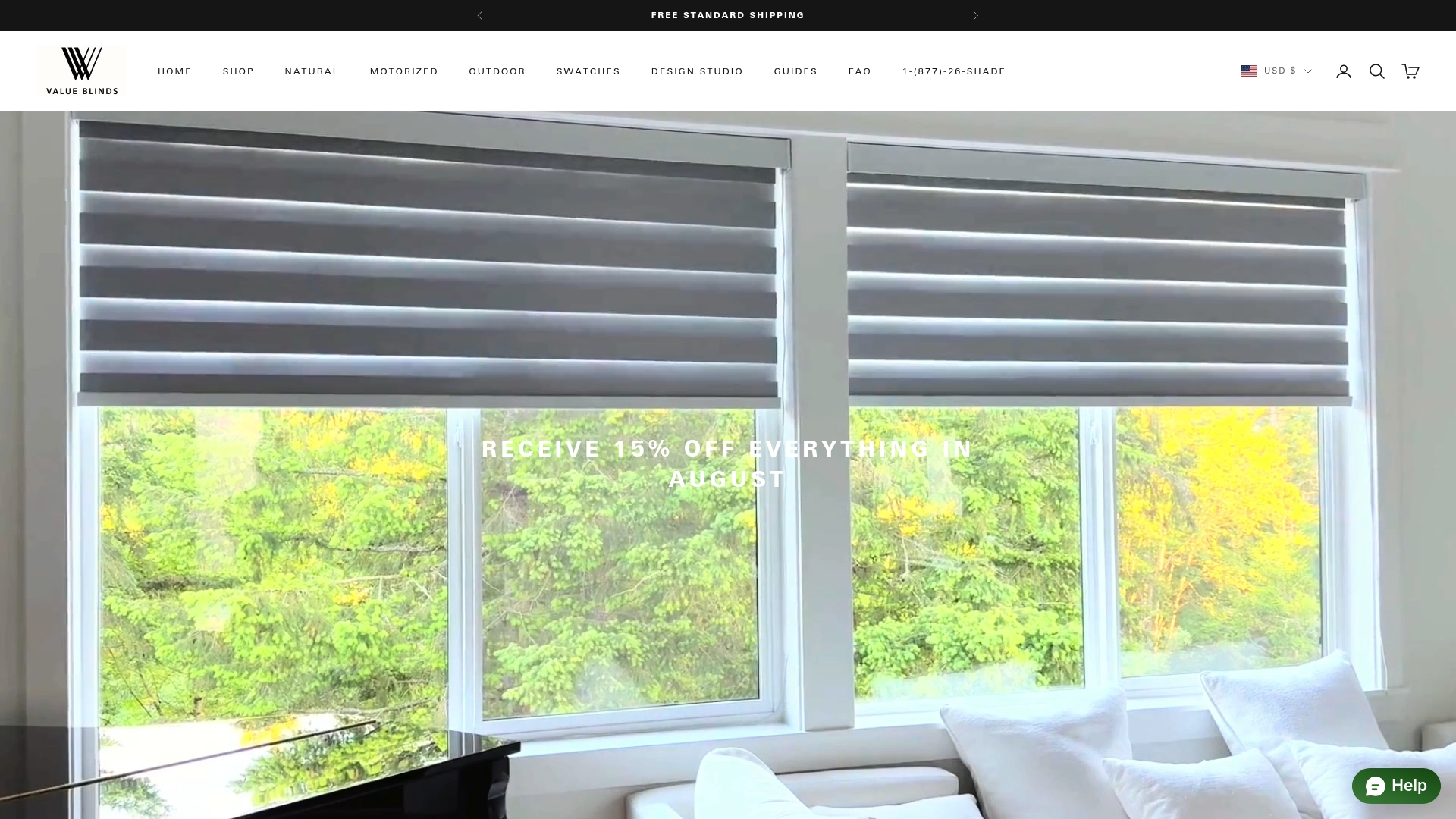
Take the stress out of window shopping and upgrade your home with our premium, customizable window treatments. Discover the latest New Arrivals or explore our complete range of solutions at Value Blinds Direct today. Choose the perfect fit for your space now—experience the difference in style, privacy, and comfort.
Frequently Asked Questions
What are the main differences between curtains and blinds?
Curtains are typically made from soft fabrics and are hung from rods, providing a more flowing aesthetic and light diffusion. Blinds are hard window coverings made from materials like wood or aluminum, featuring slats that can be adjusted for precise light control and privacy.
How do curtains and blinds affect light and privacy in my home?
Blinds allow for detailed light management by adjusting slats to control how much light enters a space. Curtains offer varying levels of light filtering depending on the fabric, making them ideal for creating a soft ambiance or complete blackout depending on the style.
What are the maintenance requirements for curtains compared to blinds?
Blinds generally require less maintenance and can be easily cleaned with a microfiber cloth. Curtains often need periodic washing or professional cleaning, especially if made from natural fibers, which may require special care.
How do I choose between curtains and blinds for my space?
Consider factors such as the room’s function, your aesthetic preferences, and the level of light and privacy control needed. Blinds work well in functional spaces like offices, while curtains can enhance the ambiance in living areas with their textural offers.



